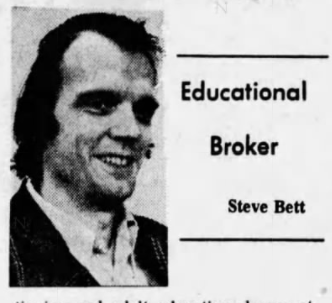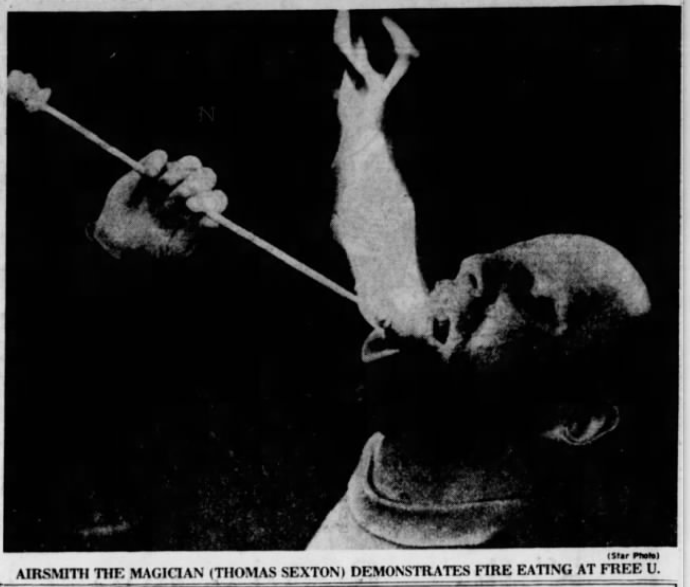Free universities that sought to provide alternative learning outside of formal education settings such as public schools or colleges were a popular idea in the 1960s and 1970s. The first Free University in the U.S. was founded at the University of California, Berkeley, in 1964. This idea took hold in Indianapolis four years later. The origins of the Free University in the city can be traced to two groups of individuals with a marked difference in ideological views. In July 1969, a coalition of teachers, students, free speech advocates, and Black militants offered 10 classes, including such controversial topics as the “History of Pornography” and the “Chemistry of Psychedelic Drugs.” These types of groups, associated with “counterculture” movements, were very typical organizers of the free universities that were established around this time.

The following summer, Ron W. Bilsky, a Ball State University (BSU) sophomore, initiated a less-militant project after attending BSU’s own rendition of a free university in summer 1969. Bilsky was able to muster enough support to offer 11 courses, and in June 1970, the announced “Ron’s latest class information.” Bilsky’s first classes were on such topics as Black history, Russian language, philosophy and contemporary political ideas, and extrasensory perception. Registration took place at Bethlehem Lutheran Church on E. 52nd Street, on the Circle, and the Student Union Building on the Indiana University School of Medicine campus. Churches, most notably Bethlehem Lutheran, and other organizations donated space.
At first, the two groups operated independently. Teachers for both were volunteers. Neither charged tuition, and their administration was so informal that one later Free University leader stated that expenses were paid by “passing the hat.” During those first few years, both groups lacked money and consistent leadership. Competing for students and teachers made their survival even more difficult. Both groups faltered as a result. They then decided to combine their efforts and start over, but even reorganized in this new combination, the Indianapolis Free University (Free U) continued to struggle, finally halting operations in late 1973.

In 1975, Steve Bett, a 36-year-old Indianapolis native and PhD candidate in communications at IUPUI, along with a small group of people who continued to be interested in the idea resurrected the Free University. This time, the group voiced its intent “to stay philosophically pure—keeping Free U as much of an open forum as ever—while providing a solid financial base and winning more exposure through wide catalog distribution.” Bethlehem Lutheran again played a key role. Its pastor Donald Elder supported the Free U by providing office and classroom space. The first year the program attracted 250 students while operating on an all-volunteer basis.
Through the late 1970s and early 1980s, Steve Bett acted as executive director, while Paul Hyatt, who owned a furniture store in Zionsville, was president. Free U also attracted the support of business executive and philanthropist Frank Basile, who was a director and served as vice president. Basile stated that he got involved because he “wanted to promote personal growth and help the organization take on a more professional air.”
By 1978, the Indianapolis Free University was the fourth-largest free university in the United States, enrolling 15,000 people in noncredit courses. The largest was located in Evanston, Illinois, where course offerings on file included more than 3,000 subjects. Approximately, 200 free universities were operating throughout the U.S. during this time.
At the height of its operation, from 1978-1982, Indianapolis Free U issued a 16-24-page catalog bimonthly with an estimated readership of 150,000. It had an office in , 10 officers and directors, and 10 paid employees. Course offerings were diverse. Dance, exercise, music, writing, drama, and language classes were especially popular. In 1982, Bett reported that a class in disco dancing had brought in $60,000. Many offbeat classes–hypnosis, fire-eating, and even a class entitled “Flying Saucer Construction and Repair,” designed as a fun way to learn about physics—found their way into the Free U curriculum. The organization held classes in over 100 places, ranging from the Beech Grove Benedictine Center to the Alley Cat Lounge.
By 1982, the organization offered over 100 classes and reported that it had about 25,000 attending each of its six-to-eight-week sessions. Free U charged a modest fee of about $14 per class. It brought in additional revenue with advertising in its catalog. At one point, the organization was successful enough that Free U directors even considered purchasing the then empty Indianapolis Public School No. 80, hoping to offset operation costs by renting space in the building that it did not use. Instead, School No. 80 eventually was adapted for reuse as a condominium complex.
Despite this once optimistic forecast, Bett reported early in 1982 that the organization had not been building up any money. The modest fees charged and advertising revenue could not keep up with the cost of providing classes to thousands of Indianapolis residents, and Free U’s debt became overwhelming. The university filed for Chapter 11 bankruptcy in September 1983, but it was not enough to save it. Free University closed on December 31, 1983.

Help improve this entry
Contribute information, offer corrections, suggest images.
You can also recommend new entries related to this topic.